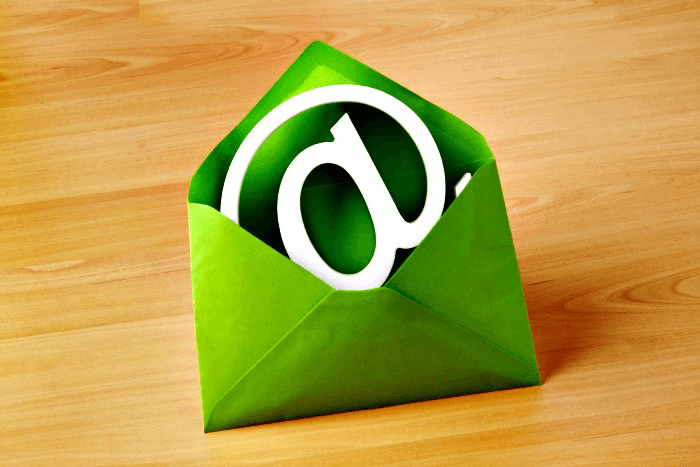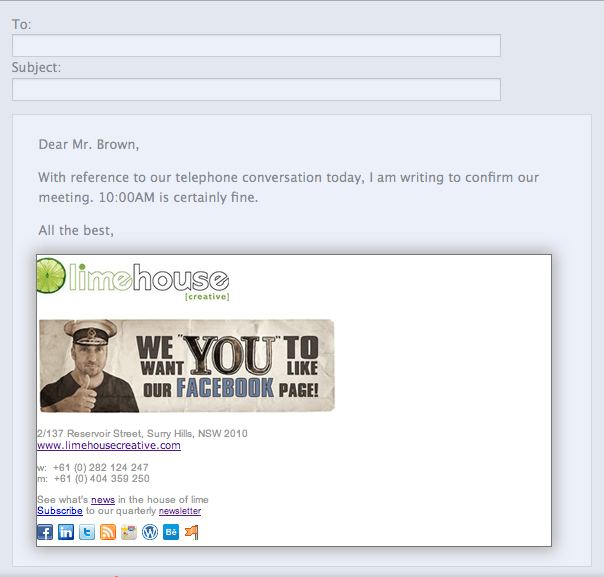
This email signature template can actually be found here
I’ll bet you’re like me: You send and receive a lot of emails. Too many, frankly; just way too many damn emails. But this piece is not about the “tyranny of email” or “the culture of busyness” or any of those very important and timely topics or conversations. No. This is a short meditation about what your email sign-off — let’s call it your “e-sig”— says about you and, if anything, all of us. As we all know, e-sigs come in an inordinate array of formats and sizes. This signature, from Vivek Wadwa, a very smart and provocative author and thinker and super nice guy, is the longest I have encountered. Every time I get Vivek’s weekly email digest, his email footer/signature makes me feel like I could be doing a lot more to make the most of my potential:
Fellow, Arthur & Toni Rembe Rock Center for Corporate Governance, Stanford University Director of Research, CERC, Pratt School of Engineering, Duke University Distinguished Scholar, Singularity University Syndicated columnist Washington Post, Contributor: Wall Street Journal, Forbes, LinkedIn Influencers, ASEE Prism Magazine Website: www.wadhwa.com , Research: http://ssrn.com/author=738704 Twitter:@wadhwa Author: The Immigrant Exodus — an Economist Book of the Year, 2012, Innovating Women — publishing on September 9th
Email signatures and footers are like some weird amalgam of the new business card and storefronts combined. E-sigs give us all the opportunity to present both while expressing as much (or little) of our inner artist as we would like. I first noticed this phenomenon when I worked in venture capital, years ago. I really thought I had arrived to the big time as a first-year “Associate” with Summit Partners, the renowned venture capital firm. You might as well have called me an “Analyst” because analyzing companies and industries was most of the job — on good days! And, everyone in the world knew it within 10 seconds. Anyhow, on my first day, in setting up my email, I just copied and pasted the e-sig used by the other Associates. It read:
Peter Sims Associate Summit Partners 500 Summer Street Boston, MA www.summitpartners.com
There was no manual telling us to do this, nor even any discussion. Like most things in small to midsized organizations, it just happened. Call it culture. Anyhow, at some point not too long after I started, I noticed that a big deal partner in the firm — kind of the head honcho in the office — had an email signature that just read (name disguised):
Rick Starkey Summit Partners 500 Summer Street Boston, MA www.summitpartners.com
Wow. Now that said something. I was struck by the fact that all of us peons were using the same footer: [our name] then our position: “Associate” beneath — as if that status was worth a damn. It obviously was not. Venture capital and private equity is one of those industries where hierarchy and position matter – a LOT. Like a lot, lot. All internal (and external!) emails, for instance, followed a similar pattern: In the “TO:” line, we added the email address of the most senior person first, then the second most senior person, and down the line, until the most lowly Associate was reached. That was me during in the spring of 2001, and I didn’t mind a bit (although I had to quickly learn the seniority pecking order; again, without anyone handing me a memo). It was a great group of people, and we had a hell of a lot of fun throughout most days, with lots of banter, pranks, and tomfoolery. It was like a locker room, for better or worse. (There were only several women on the team out of say 25 professionals then, but they kept us in line.) But Rick Starkey, well. Rick Starkey was THE MAN, well-known around Boston, New York, and beyond for being a very smart and successful investor, while being a great guy to boot. Starkey was one of the 5 “Managing Partners” at the firm. But it seemed to me like he was just “Rick Starkey” — perfectly comfortable in his own skin – and, his email footer reflected that:
Rick Starkey Summit Partners 500 Summer Street Boston, MA www.summitpartners.com
No, Rick Starkey didn’t even have to have an email footer that said “Managing Partner.” Like a Zen kōan of simplicity, Starkey know that the less he included in his email footer, the more it said about him. He might as well have just had “Stud” or “The MAN” under his name, but he didn’t have to. It was implicit. It turned out that none of the other 4 managing partners had “Managing Partner” beneath their name either, although 2 or 3 did have “Partner.” As I recall, the same was true for the say 10 or so “Vice Presidents” “Principals” or (junior) “Partners.” Just like us 20 “Associates,” loud and proud. Now, I didn’t think too much about it again until one day when I noticed that one of the other Managing Partners – let’s call him Bill O’Reilly just for kicks (we’ll just do this live, as another Bill O’Reilly famously said.) – had changed his email footer to read:
Bill O’Reilly Managing Partner Summit Partners 500 Summer Street Boston, MA www.summitpartners.com
Whoa! That was new. Whoa…Damn…. You know what? Snap! Of course, Bill O’Reilly wasn’t nearly as cool as Rick Starkey, nor was O’Reilly as successful an investor as Starkey, but on that day, he became theonly “Managing Partner” in the firm – at least according to email signatures. Most of us were just “Associates” – clearly the peons, a signature worth next to zero strategic or intrinsic value, despite our pride at having landed the hard-to-get job – or the other 4 managing partners whose e-sig just read:
Rick Starkey Summit Partners 500 Summer Street Boston, MA www.summitpartners.com
Crossing the e-sig chasm
In the wake of Bill O’Reilly’s sudden and bold email signature move, we had what the corporate behavior researcher Geoffrey Moore might call a *major* “Crossing the Chasm,” seminal moment in the firm’s 10-15 year email signature history. At that point, I talked with the associate in the cubicle next to me, Jay DeCoons (actual name), about it, who looked like a high school student at the time, and barely older than early 20s today. We discussed email etiquette and the to our innocent eyes bombshell from O’Reilly, wasting 20 to 25 minutes we could otherwise have been spending to create real value, and resulting in laughter and countless silly riffs in the coming weeks (working 70–80 hour weeks, we did have to joke and banter in order to stay sane).  Jay DeCoons (real name, actual person), fellow Associate and “adjacent cubicle occupant,” Summit Partners circa 2000–02. No longer looks like a teenager. Yet, the simple fact of the matter is that after the Bill O’Reilly (fake name) move, Jay and I really didn’t know what would happen next. We just knew that somethingwould happen because it wasn’t conceivable that 5 of the most competitive people we had ever known would be able to accept an asymmetry of e-sigs. After all, as anyone who has either worked in private equity or venture capital, or even worked near that industry knows, it is among the most competitive industries in the world. The sh*t was about to go down, and we loved it. As a quick aside, during the annual company softball game one summer evening — on a beautiful, warm evening at a field near the Boston Common — the partners (a team that included the Managing Partners, the Partners, the Principals, and the VPs) beat the Associates, thanks in no small part to a two RBI double from Bill O’Reilly in which O’Reilly literally dove headfirst into second base — full-on Pete Rose style. It was breathtaking. Of course, he was safe. The second baseman Associate probably played softball one game a year — you know, that one day we open our closet to find a beat up old mitt (if our S.O. hasn’t tossed it). Yes, he was safe, two runs scored, and the Associates team would never recover.
Jay DeCoons (real name, actual person), fellow Associate and “adjacent cubicle occupant,” Summit Partners circa 2000–02. No longer looks like a teenager. Yet, the simple fact of the matter is that after the Bill O’Reilly (fake name) move, Jay and I really didn’t know what would happen next. We just knew that somethingwould happen because it wasn’t conceivable that 5 of the most competitive people we had ever known would be able to accept an asymmetry of e-sigs. After all, as anyone who has either worked in private equity or venture capital, or even worked near that industry knows, it is among the most competitive industries in the world. The sh*t was about to go down, and we loved it. As a quick aside, during the annual company softball game one summer evening — on a beautiful, warm evening at a field near the Boston Common — the partners (a team that included the Managing Partners, the Partners, the Principals, and the VPs) beat the Associates, thanks in no small part to a two RBI double from Bill O’Reilly in which O’Reilly literally dove headfirst into second base — full-on Pete Rose style. It was breathtaking. Of course, he was safe. The second baseman Associate probably played softball one game a year — you know, that one day we open our closet to find a beat up old mitt (if our S.O. hasn’t tossed it). Yes, he was safe, two runs scored, and the Associates team would never recover.  Pete Rose sliding into base. This is basically what I saw O’Reilly do from left field, except a bit more magnified. image source: unknown I can personally verify that O’Reilly extended completely in mid-air because I was playing in left field at the time and still have etched in my memory: O’Reilly’s body, elevated in its entirety, with his arms reaching out like battering rams, suspended for 3 to 5 seconds as if in slow motion, before landing hard and sliding into second base. I can’t recall how the second baseman faired, but it wasn’t on top, that’s for sure. It was at that moment that I remember thinking to myself: “Are you kidding me? Was that for real?” I mean, O’Reilly was in his mid to late 40s at the time, with a family, and all that. And, it was then when I remember distinctly thinking out there in left field: “You know what, I just don’ think I have what it takes to make it to that level in this industry.” It was an important moment in my career, at least in hindsight, that inner voice saying, “You will get your ass kicked if you try to compete with Bill O’Reilly.” And, so it was. As I recall, Starkey played an effortless starring role in the game as well, and he was by far the most natural athlete of any of us, formerly an NCAA basketball star. The “Partners” beat the “Associates” handily, and wouldn’t stop trash talking for months — so much so, that at the annual Christmas party, the Associates all got softballs signed by the Partners team. Great laughs were had by all, and that ball is somewhere in storage as a priceless memory of those days at the firm, but I’m still using the Bose stereo we got the year before, fwiw. Now, neither Jay, my “adjacent cubicle mate,” nor I were privy to any “all-partner meetings,” so we have no way of knowing whether the question of e-sigs was resolved in private, or merely by independent user tweaks. But, after a while, a new Rick Starkey appeared on email:
Pete Rose sliding into base. This is basically what I saw O’Reilly do from left field, except a bit more magnified. image source: unknown I can personally verify that O’Reilly extended completely in mid-air because I was playing in left field at the time and still have etched in my memory: O’Reilly’s body, elevated in its entirety, with his arms reaching out like battering rams, suspended for 3 to 5 seconds as if in slow motion, before landing hard and sliding into second base. I can’t recall how the second baseman faired, but it wasn’t on top, that’s for sure. It was at that moment that I remember thinking to myself: “Are you kidding me? Was that for real?” I mean, O’Reilly was in his mid to late 40s at the time, with a family, and all that. And, it was then when I remember distinctly thinking out there in left field: “You know what, I just don’ think I have what it takes to make it to that level in this industry.” It was an important moment in my career, at least in hindsight, that inner voice saying, “You will get your ass kicked if you try to compete with Bill O’Reilly.” And, so it was. As I recall, Starkey played an effortless starring role in the game as well, and he was by far the most natural athlete of any of us, formerly an NCAA basketball star. The “Partners” beat the “Associates” handily, and wouldn’t stop trash talking for months — so much so, that at the annual Christmas party, the Associates all got softballs signed by the Partners team. Great laughs were had by all, and that ball is somewhere in storage as a priceless memory of those days at the firm, but I’m still using the Bose stereo we got the year before, fwiw. Now, neither Jay, my “adjacent cubicle mate,” nor I were privy to any “all-partner meetings,” so we have no way of knowing whether the question of e-sigs was resolved in private, or merely by independent user tweaks. But, after a while, a new Rick Starkey appeared on email:
Rick Starkey Managing Partner Summit Partners 500 Summer Street Boston, MA www.summitpartners.com
And, not too long after that, the firm’s culture changed. All 5 of the managing partners – or, should I capitalize “Managing Partners”? I wasn’t an English major – switched their footers. And before too long, our firm had hired a marketing lead, and things like that became institutionalized. Now that I’m an “author” and “social entrepreneur” – begging the oft-asked question: “Just what is it that you do?” – I have no idea how to set up my e-sig. I think about email signatures from time to time, mostly because if my ideas don’t get out into the world, I won’t eat, and the work will be for naught. So, I have what seems to be a pretty standard footer now:
peter sims talk: 415 555 6000 (will save you the urge to prank for the managing partner) www.petersims.com THE REVOLUTION WILL BE IMPROVISED
By the way, I love taglines at the bottom of e-sigs, and find inspiration in other’s taglines. And, on my iPhone footer, it just reads:
my e-sig is, peter THE REVOLUTION WILL BE IMPROVISED. forgivea typos. Sent from my phone.
(Interestingly, I’ve had at least 10 people tell me over the past year or so that I had a typo in “forgivea” but we’ll leave that to the side.)
Your e-sig, your brand, your uh…er…what are these email signatures saying about us again?
Ahem. Returning to the core point and questions: What I do find fascinating is the incredible amount of approaches to e-sigs, and email sign-offs. What’s more: Everything is branded these days, even e-sigs. And, then, everything starts to come full circle. Two of my writing role models and heroes are: Dan Pink and Malcolm Gladwell. Pink was kind enough to endorse my last book, Little Bets, and he and I probably trade emails about once a month or so about interesting articles or learnings. Dan Pink has no e-sig. He merely signs his emails: “-d” Wow, what a cool dude! Just “-d” (small caps, nothing more, nothing less.) How Zen. Dan must have attained e-sig enlightenment, the reward for being a multi-bestseller, and super-star of the business author/speaking/ideas world. Or not? And, then, amazingly, I also got an email last week from Malcolm Gladwell – from his Gmail account no less, swoon – about another recent article of mine here on Medium entitled “The Hero Returns: Steve Jobs’ real genius.”(I had sent Gladwell the article via email to an old address where I had emailed him years ago after reading (and, loving) The Tipping Point.) And, his reply was just:
“i’ll check it out! thanks for sending that peter. m.”
Whoaaa! What an experience it was to receive that email. Malcolm Gladwell had managed to put the small ‘d’ in delight, not unlike Dan Pink, except that his signature was just: “m.” (small cap ‘m’, followed by a period). That’s art, man. That’s like Apple-cool, Zen, sleek design and handling, like what it must be like to test drive a Tesla, or get one delivered. What design. What attention to detail. What elegance. What simplicity. Now, “m.”: THAT must be the mountaintop! Maybe someday: I certainly wouldn’t feel comfortable emailing everyone and saying, just: “p.” I think I would lose my girlfriend, all good friends, and contact with family, as well as virtually every work acquaintance. Other than that, it would be amazing. But this was Malcolm Gladwell. Malcolm freaking Gladwell. Gladwell. You know…“m.” It was all a bit much. Was it boring to sign: “Cheers, Peter.” Was it authentic? Blah, blah, blah… And, then I got an email from Seth Godin, also in response to the same article since both Gladwell and Godin have written about Steve Jobs and Apple in the past. “Thanks for sharing, Peter” There’s Seth Godin: No signature. Not even a period at the end of the sentence. That’s it. That’s all. ‘Nuff said. No signature. No nothing. Except, he did throw a comma in there, so clearly he exerted an amount of neurological energy, combined with moving his right middle finger down. Oh, he is good. Maybe Seth Godin is the Zen Master? Anyhow, I’ve thought about it for the past 45 minutes writing and editing this, and here’s what surfaced: My father, doesn’t have an e-sig or special sign-off either. Just “LOVE, DAD” — very simple. And, my brother, Christo, an accomplished, hard-working, and humble university professor and researcher doesn’t use an email footer at all — at least not with the emails he sends to me from his work email address. And, then come to think of it, I realize that some of the happiest people I know are the same way. There’s no thought given to either their e-sig, or the way they sign their emails. It’s just “Bill,” and “Liz,” and “Pat,” and, well as my personal favorite: “uj” from my Uncle Joe, who just really doesn’t want to waste any more time on email. So now what? Well, for those who aren’t tethered to a known platform — be it a company or a school or a nonprofit or whatever — there’s a certain amount of credibility any of us must be able to gain, and quickly, in order to do our work, spread our ideas, and eat. Building that credibility takes time to build, and feels very vulnerable and humbling when you’re just you in a huge and scary ocean. (Although, I would argue that anyone can blog for a platform like Medium and develop instant credibility and networks through the quality of your writing and ideas.) So, there’s nothing at all wrong with designing a cool or strategic or well thought out email footers, per se. And, bonus points for authentic tag lines or quotes (Here’s one I would use if I weren’t using my own: “The best way to predict the future is to invent it.” — Alan Kay). But in crafting this post, I realized that the more elaborate the e-sig, the more it (usually) ultimately says about the person, especially how confident and comfortable they are in their own skin. So, while email etiquette has been a fun curiosity, yet all too often time sink thinking about it: I’m now resolved to stop. I just want to focus on doing good work, and saving time for appreciating, listening, and loving the ones who matter. That’s all that will ultimately matter anyhow. Just my two cents. But then again, I’ll never be a Managing Partner. Now, I’m just self-conscious about my e-sig. -p. 😉
Postscript:
Due to numerous emails + notes from Medium readers following this original post, I am adding this scene from the movie “American Psycho,”entitled “Business Card Scene.” I have not seen the movie, but I now intend to — the scene is priceless, a work of art, clearly the work of some BLKSheep! Bet Malcolm Gladwell would be proud.☺
Final postscript
thoughtful email from reader> duly noted ☺ Great article, however I think you need to stop promoting Apple. “sent from my iPhone” my e-sig is peter.
Peter Sims is an author (LITTLE BETS & TRUE NORTH), an entrepreneur (cofounder of Fuse Corps), and former VC investor.



























